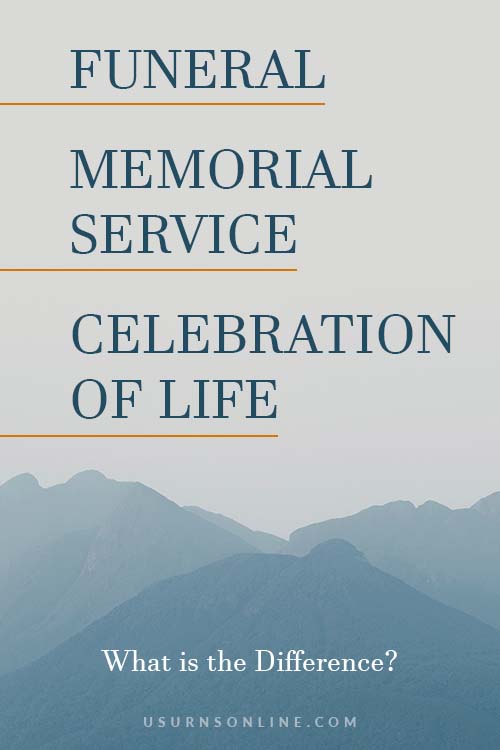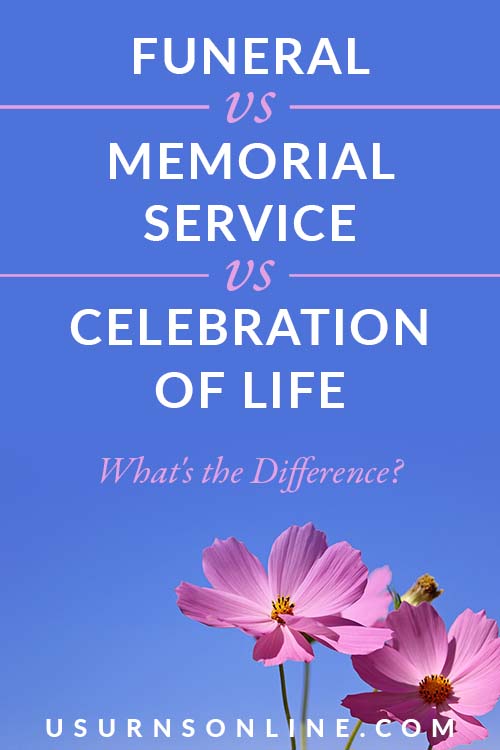What is the difference between a funeral, a memorial service and a celebration of life? These are common questions. Which is better? When and why should you choose one over any of the others?
Let’s take a look at each type of service so that you know the differences and which will work best for you, for your family, and to honor your loved one.
Funeral vs Memorial Service vs Celebration of Life
A funeral is a service to honor a deceased person with the body present, while a memorial service is a time to memorialize the individual without the body present.
A celebration of life can either have the body present or not, but the emphasis and tone of the event focuses on joyfully celebrating and remembering the decedent’s life, as opposed to mourning their death.
| Funeral | Memorial Service | Celebration of Life | |
| Body | Body present in casket | No body | Either; body or no body |
| Style | Traditional | Personalized; casual yet respectful | Informal and creative |
| Tone | Somber and dignified | Grief mixed with happy memories | Celebratory and commemorative – sometimes a literal party |
| Location | Funeral home or church | Church, funeral home, fellowship hall, community center | Anywhere |
Next, we’ll go in-depth on these three types of service and see what makes each one unique.
Funeral Service
A funeral is the classic, traditional ceremony to remember the dead and to lay their body to rest. Generally speaking, a funeral will be more formal, more circumspect, and more somber than a celebration of life.
Most often, the funeral will take place at the funeral home, though sometimes you can do this at church or even at home. The reception can be at the same location or a different one, depending on the arrangements you make and the available facilities.
Most funerals involve four elements: visitation, funeral service, committal, and reception.
1. Visitation
The visitation or viewing is a time before the funeral where family and loved ones can gather to offer comfort to one another, share memories and often a light appetizer, and, if desired, pay respects to the decedent in an open casket.
This can be a private gathering by invitation only, or open to the public. Some families prefer to have it at home, but most often it is held at the funeral home or at the location of the funeral.
Urns Made in the USA
2. Funeral Service
Next comes the funeral service itself, which can include readings, prayers, eulogies, music, and any memorial tributes the family finds appropriate.
For a funeral, most attendees wear formal clothes in black or dark colors. The auditorium can be decorated with flowers, and the casket will be up front, often alongside a large photo display.
The tone of the service is often restrained and somber, recognizing the gravity of the occasion. Weeping and other displays of grief as well as humorous jokes and lighthearted stories are certainly permissible and even encouraged, but the overall sensibility of the funeral service is one of respect and decorum.
3. Committal
Immediately after the service the body is laid to rest. This is known as a committal, or graveside service. Most often this means a funeral procession to the cemetery where the body is buried in a short ceremony.
A clergy member, funeral director, or family member will officiate the committal. The officiant will say a few brief words about the person, read Scriptures or other texts, lead in singing hymns, and provide a time for final goodbyes prior to the lowering and burial of the casket.
However, with the increasing popularity of cremation, instead of a committal the body may be taken to the crematorium and the ashes scattered, buried, placed in a columbarium niche, or taken home in a cremation urn at a later date. In that case the funeral service moves immediately into the reception.
4. Reception
After the service (and committal, if done at this time) the family typically invites attendees to a reception. At the reception, the formality of the funeral service slowly dissolves as relatives and friends break bread together, sharing the comforts of a meal and one another’s company, along with stories and memories of the departed loved one.
The reception is an important part of the grieving process and helps many in your wider community to move forward from sheer sadness at the loss of someone meaningful in their life.
Related: What is the Difference Between Celebration of Life & Funeral Service?
Memorial Service
Memorial services can be very similar to a funeral. However, with the body not being present, memorial services allow for much greater flexibility. You have more options for the time and place.
For this reason, you can schedule memorial services weeks or even months after the death, to accommodate traveling family members or other circumstantial issues. Since the disposition will have happened within about a week of the passing, as time and physical distance from the death increases the somber formality typical of funerals tends to decrease. This means that simply due to human nature the memorial service tends to be less solemn.
Community centers, event centers, parks, and even a family member’s home can be the venue. The time can be right away or months and even years after the death. The service can be long or short, elaborate or simple, formal or informal.
If the person has been cremated and the remains are present at the service, it is still typically known as a memorial service. “Funeral” is reserved for when the body as such is present in a casket.
More: 55 Creative Memorial Service Ideas
Celebration of Life
A celebration of life is simply a funeral or memorial service by another name. However, when people use this term, they are usually consciously try to get away from the sad and depressing element of death and focus on remembering and commemorating the person’s life.
This often results in more of a “party” atmosphere, a celebratory gathering of family and friends. Creative ideas like these are often the focus along with telling stories and other memories about the individual.
Food and drink abound. You’ll also encounter art, music, and themes that showcase the person’s individuality, such as gardening, a favorite NFL team, their hobby collections, and so on.
Now that you know the difference between funerals, memorial services, and life celebrations, you can plan exactly what you want each step along the way to honor your beloved. Read our Funeral Planning Guide for everything you need to know. (And yes, it applies to memorial services and life celebrations too!)
Read Next: What is Exploding Casket Syndrome
Pin It






Thank you for describing the difference between a funeral service and a memorial service. That is good to know that at a memorial service the body isn’t present and you have greater flexibility with what happens. My family and I are wondering if we should hold a memorial service instead of a funeral for our loved one. So, thank you again for the information.
It is better to understand that there is a big difference between a funeral and memorial service. It would be a big eye-opener to know them both. Thank you for sharing!
I had always assumed that funerals were only held in a funeral home. It’s good to know that the funeral home could help hold a funeral at any fitting location. I know my dad would like to have his funeral out in his garden.
Thanks for discussing the differences between a funeral and a memorial service. My dad recently passed away in his sleep. He was a veteran, so we want to make sure he has a special funeral service.